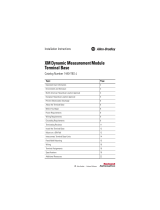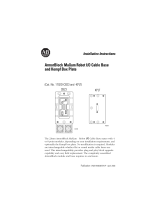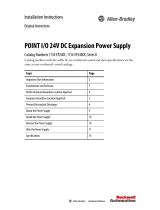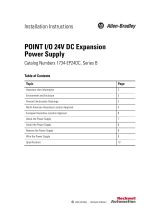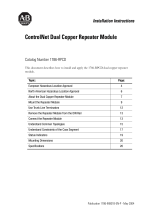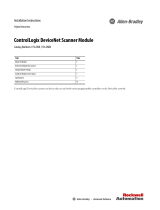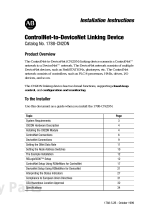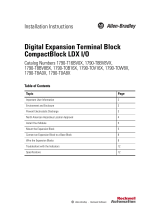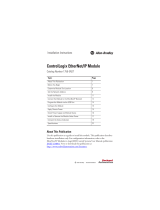La page est en cours de chargement...

2 XM-124 Standard Dynamic Measurement Module
Rockwell Automation Publication 1440-IN001B-EN-P - October 2013
Important User Information
Solid-state equipment has operational characteristics differing from those of electromechanical equipment. Safety Guidelines
for the Application, Installation and Maintenance of Solid State Controls (publication SGI-1.1
available from your local Rockwell
Automation sales office or online at http://www.rockwellautomation.com/literature/
) describes some important differences
between solid-state equipment and hard-wired electromechanical devices. Because of this difference, and also because of the
wide variety of uses for solid-state equipment, all persons responsible for applying this equipment must satisfy themselves that
each intended application of this equipment is acceptable.
In no event will Rockwell Automation, Inc. be responsible or liable for indirect or consequential damages resulting from the use
or application of this equipment.
The examples and diagrams in this manual are included solely for illustrative purposes. Because of the many variables and
requirements associated with any particular installation, Rockwell Automation, Inc. cannot assume responsibility or liability for
actual use based on the examples and diagrams.
No patent liability is assumed by Rockwell Automation, Inc. with respect to use of information, circuits, equipment, or software
described in this manual.
Reproduction of the contents of this manual, in whole or in part, without written permission of Rockwell Automation, Inc., is
prohibited.
Throughout this manual, when necessary, we use notes to make you aware of safety considerations.
WARNING: Identifies information about practices or circumstances that can cause an explosion in a
hazardous environment, which may lead to personal injury or death, property damage, or economic loss.
ATTENTION: Identifies information about practices or circumstances that can lead to personal injury or
death, property damage, or economic loss. Attentions help you identify a hazard, avoid a hazard and
recognize the consequences.
SHOCK HAZARD: Labels may be on or inside the equipment, for example, a drive or motor, to alert people
that dangerous voltage may be present.
BURN HAZARD: Labels may be on or inside the equipment, for example, a drive or motor, to alert people
that surfaces may reach dangerous temperatures.
IMPORTANT Identifies information that is critical for successful application and understanding of the product.

XM-124 Standard Dynamic Measurement Module 3
Rockwell Automation Publication 1440-IN001B-EN-P - October 2013
North American Hazardous Location Approval
The following information applies when
operating this equipment in hazardous
locations.
Informations sur l’utilisation de cet équipement
en environnements dangereux.
Products marked "CL I, DIV 2, GP A, B, C, D" are
suitable for use in Class I Division 2 Groups A, B, C, D,
Hazardous Locations and nonhazardous locations
only. Each product is supplied with markings on the
rating nameplate indicating the hazardous location
temperature code. When combining products within
a system, the most adverse temperature code
(lowest "T" number) may be used to help determine
the overall temperature code of the system.
Combinations of equipment in your system are
subject to investigation by the local Authority
Having Jurisdiction at the time of installation.
Les produits marqués "CL I, DIV 2, GP A, B, C, D" ne
conviennent qu'à une utilisation en environnements de
Classe I Division 2 Groupes A, B, C, D dangereux et non
dangereux. Chaque produit est livré avec des marquages
sur sa plaque d'identification qui indiquent le code de
température pour les environnements dangereux.
Lorsque plusieurs produits sont combinés dans un
système, le code de température le plus défavorable
(code de température le plus faible) peut être utilisé
pour déterminer le code de température global du
système. Les combinaisons d'équipements dans le
système sont sujettes à inspection par les autorités
locales qualifiées au moment de l'installation.
WARNING:
Explosion Hazard -
• Do not disconnect equipment
unless power has been removed or
the area is known to be
nonhazardous.
• Do not disconnect connections to
this equipment unless power has
been removed or the area is known
to be nonhazardous. Secure any
external connections that mate to
this equipment by using screws,
sliding latches, threaded
connectors, or other means
provided with this product.
• Substitution of components may
impair suitability for Class I,
Division 2.
• If this product contains batteries,
they must only be changed in an
area known to be nonhazardous.
AVERTISSEMENT:
Risque d’Explosion –
• Couper le courant ou s'assurer que
l'environnement est classé non
dangereux avant de débrancher
l'équipement.
• Couper le courant ou s'assurer que
l'environnement est classé non
dangereux avant de débrancher les
connecteurs. Fixer tous les
connecteurs externes reliés à cet
équipement à l'aide de vis, loquets
coulissants, connecteurs filetés ou
autres moyens fournis avec ce produit.
• La substitution de composants peut
rendre cet équipement inadapté à une
utilisation en environnement de
Classe I, Division 2.
• S'assurer que l'environnement est
classé non dangereux avant de
changer les piles.

4 XM-124 Standard Dynamic Measurement Module
Rockwell Automation Publication 1440-IN001B-EN-P - October 2013
Wiring Requirements
Use solid or stranded wire. All wiring must meet the following specifications:
• 14…22 AWG copper conductors without pretreatment; 8 AWG
required for grounding the DIN rail for electromagnetic interference
(EMI) purposes
• Recommended strip length 8 mm (0.31 in.)
• Minimum insulation rating of 300V
• Soldering the conductor is forbidden
• Wire ferrules can be used with stranded conductors; copper ferrules
recommended
Install the Module
To install the XM-124 Standard Dynamic Measurement Module, follow these
steps.
1. Mount the terminal base unit.
2. Wire the module.
3. Mount the module.
4. Connect the power supply.
5. Connect the channel outputs.
6. Establish a serial port connection.
7. Establish a DeviceNet connection.
ATTENTION: The XM-124 Dynamic Measurement Module is certified and
approved for use only in the 1440-TB-A/C terminal base unit. Do not install
the XM-124 module in any other terminal base unit.

XM-124 Standard Dynamic Measurement Module 5
Rockwell Automation Publication 1440-IN001B-EN-P - October 2013
Mount the Terminal Base Unit
The XM family includes several terminal base units to serve all of the XM
modules. The 1440-TB-A/C terminal base unit is the only terminal base unit
used with the Standard Dynamic Measurement Module (catalog number
1440-SDM02-01RA).
The terminal base unit can be DIN rail or panel mounted.
DIN Rail Mounting
Use the following steps to mount the terminal base unit on a DIN rail
(Allen-Bradley catalog number 199-DR1 or 199-DR4).
WARNING: If you insert or remove the module while backplane power is on, an
electrical arc can occur. This could cause an explosion in hazardous location
installations.
Be sure that power is removed or the area is nonhazardous before proceeding.
ATTENTION : Do not remove or replace a terminal base unit while power is
applied. Interruption of the backplane can result in unintentional operation
or machine motion.

6 XM-124 Standard Dynamic Measurement Module
Rockwell Automation Publication 1440-IN001B-EN-P - October 2013
1. Position the terminal base unit on the 35 x 7.5 mm DIN rail (A).
2. Slide the terminal base unit over, leaving room for the side
connector (B).
3. Rotate the terminal base unit onto the DIN rail with the top of the rail
hooked under the lip on the rear of the terminal base unit.
31887-M
B
A
A
31883-M

XM-124 Standard Dynamic Measurement Module 7
Rockwell Automation Publication 1440-IN001B-EN-P - October 2013
4. Press down on the terminal base unit to lock the terminal base unit onto
the DIN rail.
If the terminal base unit does not lock into place, use a screwdriver or similar
device to open the locking tab, press down on the terminal base unit until it is
flush with the DIN rail, and release the locking tab to lock the base in place.
Wire the Module
Wiring to the module is made through the terminal base unit on which the
module mounts. The XM-124 module is compatible only with the XM-940
terminal base unit, catalog number 1440-TB-A.
XM-940 Terminal Base Unit
XM-940 (catalog number 1440-TB-A)

8 XM-124 Standard Dynamic Measurement Module
Rockwell Automation Publication 1440-IN001B-EN-P - October 2013
Terminal Block Assignments
The terminal block assignments for the XM-124 Standard Dynamic
Measurement Module are detailed in this section.
TIP
The XM module’s revision number is on the product label, which is
on the front of the XM module, as shown on the example below
(actual product label can have different ratings).
WARNING: EXPLOSION HAZARD. Do not disconnect connections to this
equipment unless power has been removed or the area is known to be
nonhazardous. Secure any external connections that mate to this equipment
by using screws, sliding latches, threaded connectors, or other means
provided with this product.
Revision Number
of XM Module

XM-124 Standard Dynamic Measurement Module 9
Rockwell Automation Publication 1440-IN001B-EN-P - October 2013
Terminal Block Assignments
No. Name Description
0 Xducer 1 (+) Vibration transducer 1 connection
1 Xducer 2 (+) Vibration transducer 2 connection
2 Buffer 1 (+) Vibration signal 1 buffered output
3 Buffer 2 (+) Vibration signal 2 buffered output
4 Tach/Signal In (+) Tachometer transducer/signal input, positive side
5 Buffer Power 1 IN Channel 1 buffer power input
Connect to terminal 6 for positive bias transducers or terminal 21 for
negative bias transducers
6 Positive Buffer Bias Provides positive (-5...24V) voltage compliance to buffered outputs
Connect to terminals 5 (CH 1) and 22 (CH 2) for positive bias transducers
7 TxD Personal computer serial port, transmit data
8 RxD Personal computer serial port, receive data
9XRTN
1
Circuit return for TxD and RxD
10 Chassis Connection to DIN-rail ground spring or panel mounting hole
11 4-20 mA 1 (+) 4…20 mA output
300Ω maximum load
12 4-20 mA 1 (-)
13 Chassis Connection to DIN-rail ground spring or panel mounting hole
14 Chassis Connection to DIN-rail ground spring or panel mounting hole
15 Chassis Connection to DIN-rail ground spring or panel mounting hole
16 Xducer 1 (-)
1
Vibration transducer 1 connection
17 Xducer 2 (-)
1
Vibration transducer 2 connection
18 Signal Common
1
Vibration buffered output return
19 TACH Buffer Tachometer transducer/signal output
20 Tachometer (-) Tachometer transducer/signal return, TACH Buffer return

10 XM-124 Standard Dynamic Measurement Module
Rockwell Automation Publication 1440-IN001B-EN-P - October 2013
21 Buffer/Xducer Pwr
(-)
Provides negative (-24...9V) voltage compliance to buffered outputs
Connect to terminals 5 (CH 1) and 22 (CH 2) for negative bias transducers
Transducer power supply output, negative side; used to power external
sensor (40 mA maximum load)
22 Buffer Power 2 IN Channel 2 buffer power input
Connect to terminal 6 for positive bias transducers or terminal 21 for
negative bias transducers
23 CAN_High DeviceNet bus connection, high differential (white wire)
24 CAN_Low DeviceNet bus connection, low differential (blue wire)
25 +24 V Out Internally connected to 24V In (terminal 44)
Used to daisy chain power if XM modules are not plugged into each other
If power is not present on terminal 44, there is no power on this terminal
26 DNet V (+) DeviceNet bus power input, positive side (red wire)
27 DNet V (-) DeviceNet bus power input, negative side (black wire)
28 24 V Common
1
Internally connected to 24V Common (terminals 43 and 45)
Used to daisy chain power if XM modules are not plugged into each other
29 4-20 mA 2 (+) 4...20 mA output
300Ω maximum load
30 4-20 mA 2 (-)
31 Chassis Connection to DIN-rail ground spring or panel mounting hole
32 Chassis
33 Chassis
34 Chassis
35 Chassis
36 Chassis
37 Chassis
38 Chassis
39 SetPtMult Switch input to activate Set Point Multiplication (active closed)
40 Switch RTN Switch return, shared between SetPtMult and Reset Relay
Terminal Block Assignments
No. Name Description

XM-124 Standard Dynamic Measurement Module 11
Rockwell Automation Publication 1440-IN001B-EN-P - October 2013
1 Terminals are internally connected and isolated from the chassis terminals.
Mount the Module
The XM-124 Standard Dynamic Measurement Module (catalog
number1440-SDM02-01RA) is used only with the 1440-TB-A/C terminal base
unit.
41 Reset Relay Switch input to reset internal relay (active closed)
42 Reserved
43 24 V Common
1
Internally DC-coupled to circuit ground
44 +24 V In Connection to primary external +24V power supply, positive side
45 24 V Common
1
Connection to external +24V power supply, negative side (internally
DC-coupled to circuit ground)
46 Reserved
47 Relay Common Relay Common contact
48 Relay N.O. Relay Normally Open contact
49 Reserved
50 Reserved
51 Reserved
WARNING: An electrical arc can occur if you do the following:
• Insert or remove the module while backplane power is on
• Connect or disconnect wiring while the field-side power is on
This can cause an explosion in hazardous location installations. Be sure that
power is removed or the area is nonhazardous before proceeding.
IMPORTANT
Install the overlay slide label to protect the serial connector and electronics
when the serial port is not in use.
Terminal Block Assignments
No. Name Description

12 XM-124 Standard Dynamic Measurement Module
Rockwell Automation Publication 1440-IN001B-EN-P - October 2013
1. Make certain the keyswitch (D) on the terminal base unit (E) is at
position 1 as required for the module.
2. Make certain the side connector (B) is pushed all the way to the left.
You cannot install the module unless the connector is fully extended.
3. Make sure that the pins on the bottom of the module are straight so they
will align properly with the connector in the terminal base unit.
4. Position the module (A) with its alignment bar (G) so that it is aligned
with the groove (F) on the terminal base unit.
5. Press firmly and evenly to seat the module in the terminal base unit.
The module is seated when the latching mechanism (C) is locked into
the module.
6. Repeat the above steps to install the next module in its terminal base
unit.

XM-124 Standard Dynamic Measurement Module 13
Rockwell Automation Publication 1440-IN001B-EN-P - October 2013
Connect the Power Supply
Power supplied to the module must be 24V DC nominally (±10%) and must be
a Class 2 rated source.
Wire the DC-input power supply to the terminal base unit as shown below.
DC Input Power Supply Connection
IMPORTANT
A Class 2 circuit can be provided by use of an NEC Class 2 rated power
supply, or by using a SELV or PELV rated power supply with a 5 A current
limiting fuse installed before the XM module.
IMPORTANT
24V DC must be wired to terminal 44 (+24V In) to provide power to the
device and other XM modules linked to the wired terminal base unit via
the side connector.
ATTENTION : The power connections vary for different XM modules. Refer to
the installation instructions for your specific XM module for complete wiring
information.

14 XM-124 Standard Dynamic Measurement Module
Rockwell Automation Publication 1440-IN001B-EN-P - October 2013
Serial Port Connection
The XM-124 module includes a serial port connection, which lets you connect a
personal computer and configure the module’s parameters via the Serial
Configuration software utility.
There are two methods of connecting an external device to the module’s serial
port:
•Terminal base unit - There are three terminals on the terminal base unit
that you can use for the serial port connection. They are TxD, RxD, and
RTN (terminals 7, 8, and 9, respectively). If these three terminals are
wired to a DB-9 female connector, then a standard RS-232 serial cable
with 9-pin (DB-9) connectors can be used to connect the module to a
personal computer (no null modem is required). The DB-9 connector
must be wired to the terminal block as follows.
•Mini-connector - The mini-connector is on the top of the module, as
shown below.
Mini-connector
A special cable (catalog number1440-SCDB9FXM2) is required for this
connection.
Product Name/Title Terminal Base Unit
(catalog number 1440-TB-A)
DB-9 Female Connector
TX Terminal (terminal 7) ---------------------- Pin 2 (RD - receive data)
RX Terminal (terminal 8) ---------------------- Pin 3 (TD - transmit data)
RTN Terminal (terminal 9) --------------------- Pin 5 (SG - signal ground)
Mini-connector

XM-124 Standard Dynamic Measurement Module 15
Rockwell Automation Publication 1440-IN001B-EN-P - October 2013
The connector that inserts into the personal computer is a DB-9 female
connector, and the connector that inserts into the module is a USB Mini-B male
connector. The default communication rate is 19.2 Kbps.
DeviceNet Connection
The XM-124 module includes a DeviceNet connection that allows the modules
to communicate with a programmable logic controller (PLC), distributed
control system (DCS), or another XM module.
The DeviceNet network is an open, global, industry-standard communication
network designed to provide an interface through a single cable from a
programmable controller to a smart device, such as the XM-124 module. As
multiple XM modules are interconnected, the DeviceNet network also serves as
the communication bus and protocol that efficiently transfers data between the
XM modules.
WARNING: If you connect or disconnect the serial cable with power applied
to the module or the serial device on the other end of the cable, an electrical
arc can occur. This could cause an explosion in hazardous location
installations. Be sure that power is removed or the area is nonhazardous
before proceeding.
IMPORTANT
If 24V Common is not referenced to earth ground, we recommend that you use an
RS-232 isolator, such as Phoenix PSM-ME-RS232/RS232-P (catalog number
1440-ISO-232-24), to protect both the XM module and the computer.

16 XM-124 Standard Dynamic Measurement Module
Rockwell Automation Publication 1440-IN001B-EN-P - October 2013
Connect the DeviceNet cable to the terminal base unit as follows.
DeviceNet Cable Connections
Connect To Terminal
Red wire DNet V+ 26 (optional)
White wire CAN High 23
Bare wire Shield (Chassis) 10
Blue wire CAN Low 24
Black wire DNet V- 27
IMPORTANT
The DeviceNet power circuit through the XM module interconnect, which is rated
at only 300 mA, is not intended or designed to power DeviceNet loads. Doing so
could damage the module or terminal base unit.
IMPORTANT
If the module is configured to operate in Normal mode (fully ODVA compliant),
DNet V+ must be connected. Refer to the ‘Set the Module DIP Switch’ section of
the XM-124 Standard Dynamic Measurement Module User Manual, publication
1440-UM001
.
ATTENTION: You must ground the DeviceNet shield at only one location.
Connecting the DeviceNet shield to terminal 10 grounds the DeviceNet
shield at the XM module. If you intend to terminate the shield elsewhere, do
not connect the shield to terminal 10.
ATTENTION: The DeviceNet network must also be referenced to earth
ground at only one location. Connect DNet V- to earth ground or chassis at
one of the XM modules.

XM-124 Standard Dynamic Measurement Module 17
Rockwell Automation Publication 1440-IN001B-EN-P - October 2013
DeviceNet Mode, Communication Rate, and Address
Under the slide at the top of the module is a 10-position DIP switch that is used
for setting the modules’ DeviceNet behavior, node address, and communication
rate. The switches are numbered from left to right and are applied as shown in
the illustration below and in the following table.
DIP Switch Bank
ATTENTION : The DNet V+ and DNet V- terminals are inputs to the XM
module. Do not attempt to pass DeviceNet power through the XM terminal
base unit to other non-XM equipment by connecting to these terminals.
Failure to comply can result in damage to the XM terminal base unit and/or
other equipment.
IMPORTANT
I
Terminate the DeviceNet network and adhere to the requirements and
instructions in the ODVA Planning and Installation Manual - DeviceNet Cable Sys-
tem, which is available on the ODVA website http://www.odva.org.

18 XM-124 Standard Dynamic Measurement Module
Rockwell Automation Publication 1440-IN001B-EN-P - October 2013
DIP Switch Functions and Defaults
Switch Purpose Function Out-of-box
Default
Value
Out-of-box
Switch
Setting
1DIP switch
disable
Determines whether DIP switches 3…10
are enabled. When this switch is in the off
position, DIP switches 3…10 set the
module’s node address and communication
rate. When the switch is on, the device
ignores DIP switches 3…10 and uses the
network address and communication rate
programmed in nonvolatile storage.
Switches
enabled
Off
2Network
mode
Sets the DeviceNet behavior of the module
to either Normal mode (ODVA compliant) or
Legacy mode, which is consistent with
earlier XM module versions.
Normal (fully
compliant)
On
3, 4 Data rate When switch 1 is off (0), the DeviceNet
communication rate is set.
125 Kbps Both off
5…10 Node
address
When switch #1 is off (0), the DeviceNet
node address is set.
63 All on

XM-124 Standard Dynamic Measurement Module 19
Rockwell Automation Publication 1440-IN001B-EN-P - October 2013
Additional Resources
These documents contain additional information concerning related products
from Rockwell Automation.
You can view or download publications at
http://www.rockwellautomation.com/literature/
. To order paper copies of
technical documentation, contact your local Allen-Bradley distributor or
Rockwell Automation sales representative.
Resource Description
XM-124 Dynamic Measurement Module User
Manual, publication 1400-UM001
Provides additional details on the installation of the
XM-124 as well as module configuration, operation,
and technical specifications.
Industrial Automation Wiring and Grounding
Guidelines, publication 1770-4.1
Provides general guidelines for installing a Rockwell
Automation® industrial system.
Product Certifications website, http://www.ab.com
Provides declarations of conformity, certificates, and
other certification details.

Rockwell Automation Support
Rockwell Automation provides technical information on the Web to assist you in using its products.
At http://www.rockwellautomation.com/support
, you can find technical manuals, technical and application notes, sample
code and links to software service packs, and a MySupport feature that you can customize to make the best use of these tools.
You can also visit our Knowledgebase at http://www.rockwellautomation.com/knowledgebase
for FAQs, technical information,
support chat and forums, software updates, and to sign up for product notification updates.
For an additional level of technical phone support for installation, configuration and troubleshooting, we offer TechConnect
SM
support programs. For more information, contact your local distributor or Rockwell Automation representative, or visit
http://www.rockwellautomation.com/support/
.
Installation Assistance
If you experience a problem within the first 24 hours of installation, please review the information that's contained in this
manual. You can also contact a special Customer Support number for initial help in getting your product up and running.
New Product Satisfaction Return
Rockwell Automation tests all of its products to help ensure that they are fully operational when shipped from the
manufacturing facility. However, if your product is not functioning and needs to be returned, follow these procedures.
Documentation Feedback
Your comments will help us serve your documentation needs better. If you have any suggestions on how to improve this
document, complete this form, publication RA-DU002
, available at http://www.rockwellautomation.com/literature/.
United States or Canada 1.440.646.3434
Outside United States or
Canada
Use the Worldwide Locator
at
http://www.rockwellautomation.com/rockwellautomation/support/overview.page
, or contact
your local Rockwell Automation representative.
United States
Contact your distributor. You must provide a Customer Support case number (call the phone
number above to obtain one) to your distributor to complete the return process.
Outside United States Please contact your local Rockwell Automation representative for the return procedure.
Publication 1440-IN001B-EN-P - October 2013 PN-218576
Supersedes 1440-IN001A-EN-P - January 2013 Copyright © 2013 Rockwell Automation, Inc. All rights reserved. Printed in the U.S.A.
Allen-Bradley, Rockwell Software, and Rockwell Automation are trademarks of Rockwell Automation, Inc.
Trademarks not belonging to Rockwell Automation are property of their respective companies.
Rockwell Otomasyon Ticaret A.Ş., Kar Plaza İş Merkezi E Blok Kat:6 34752 İçerenköy, İstanbul, Tel: +90 (216) 5698400
/

